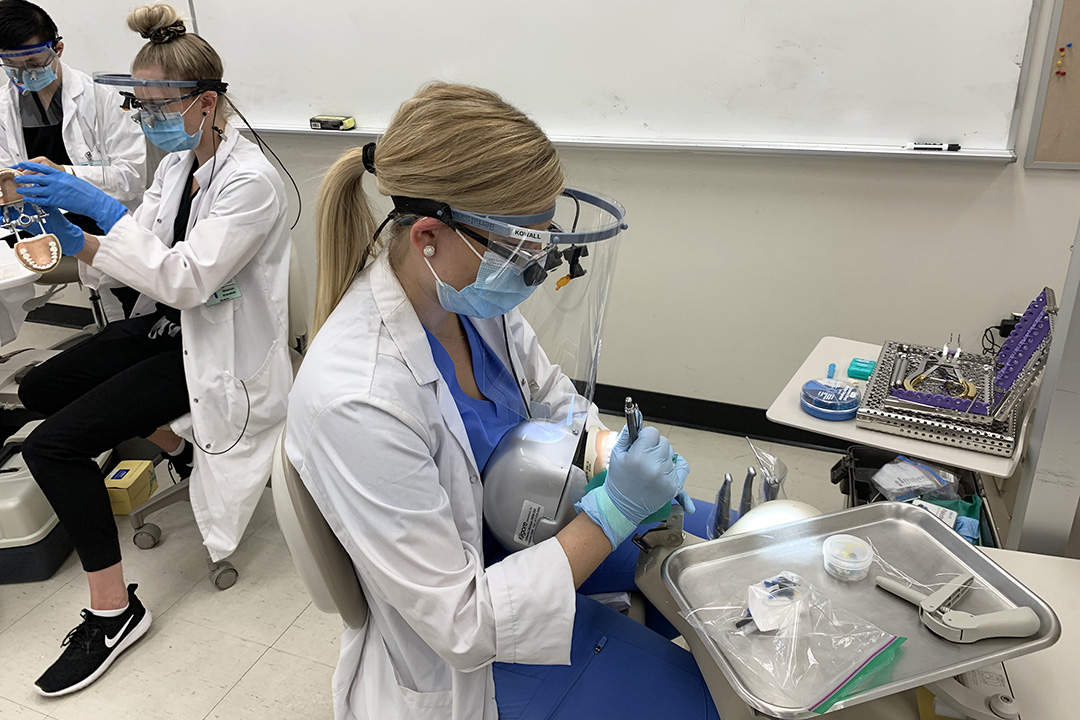
USask College of Dentistry adapts to COVID-19
The ongoing COVID-19 pandemic has required colleges across the University of Saskatchewan (USask) to make significant changes in their educational programming.
By Jenna FraserIn addition to shifting classroom activities to virtual learning, the College of Dentistry has had to develop and adopt new protocols in the patient care clinics that are open to the public and in the training simulation clinics, as students are required to be on campus to complete the psychomotor skill components of their education.
“We have worked closely with the university, the Saskatchewan Health Authority, and the College of Dental Surgeons of Saskatchewan (CDSS) to implement additional COVID-specific infection control and safety protocols in our clinical and preclinical programs,” said Dr. Doug Brothwell (DMD), dean of the College of Dentistry. “Our regulatory body, CDSS, have mandated significant changes in infection control protocol for clinics across the province, and we spent the last couple of months planning, designing, and implementing these changes so that our clinics could reopen for the fall semester.”
While all Saskatchewan dental clinics are adapting to these new changes, the College of Dentistry was presented with a unique challenge: the size of its clinical operation. The college’s patient care clinics include close to 100 dental chairs used by approximately 155 students, 15 staff and 25 faculty working in the clinical program.
To best ensure patient, student, staff and faculty safety, the college has developed new protocols for clinical care, including increased levels of personal protective equipment (PPE), rearranging schedules to limit the amount of time students are on campus, changing and renovating the clinics to allow for fully enclosed operatories (dental treatment areas), and finding a new way for instructors to provide supervision to students working in enclosed spaces.
“Aerosols are generated during a large number of different dental procedures, and must be strictly managed to prevent the spread of COVID-19. As a result, the college needed to add fully enclosed operatories for our students to work in to prevent the risk of virus transmission,” Brothwell said.
“The new enclosed treatment rooms allow us to leave operatories undisturbed (quarantined) for a specified amount of time to ensure aerosols have settled before re-entering and disinfecting the rooms according to the new protocols. One notable addition to the disinfection protocol is the addition of room fogging devices that discharge an anti-viral disinfecting solution that is approved by Health Canada for COVID-19.”
The fully enclosed operatories presented another challenge for the college. With the number of students working in the clinic at one time, it is not feasible to have a faculty member present and supervising students in each enclosed operatory. Additionally, it would be ineffective under the new PPE protocols to have supervising instructors circulate in and out of the enclosed operatories supervising several students as was done in the past, since this defeats the purpose of the enclosed room.
In response to this challenge, the college decided to pilot a remote audio-visual supervision strategy.
“We are in the process of equipping two enclosed operatories with a microphone and speaker for audio communication and two cameras: a webcam which will be mounted to provide an overall view of the patient and the student during a clinical procedure; and an intra-oral camera with which the student can provide high resolution, close-up views of the treatment being provided,” said Dr. Alan Heinrichs (DMD), assistant dean, clinics. “The clinical supervisor, via a WebEx link, will be able to remotely view X-rays, observe the process of care, and provide instruction or evaluation on the progress and quality of care being provided.”
The goal of this pilot strategy is that the instructor need only to enter the enclosed operatory once, ideally at the end of the procedure to evaluate the final result, but also more often in those situations where it is required.
“The health and safety of patients, students, faculty and staff were top priority for the College of Dentistry when our students returned and our patient care clinics and simulation clinics reopened in the latter parts of August,” said Brothwell. “The college continues to be in contact with university leadership, the health authority, and our regulatory body, and will continue to monitor and update our clinical protocols as more information regarding COVID-19 becomes available.”

